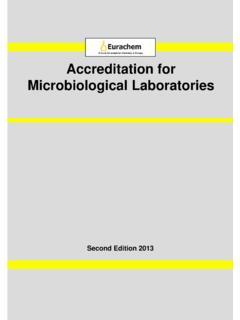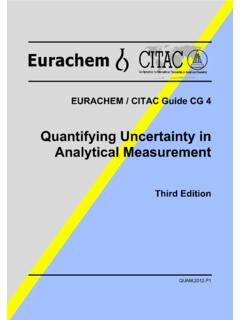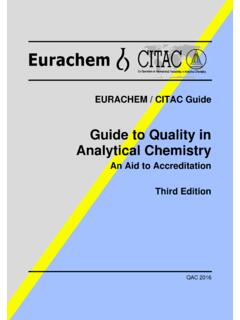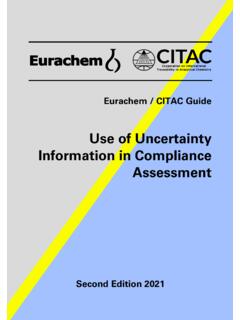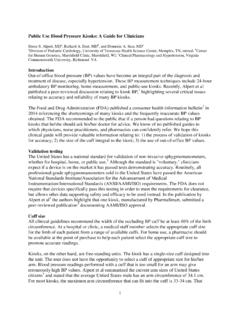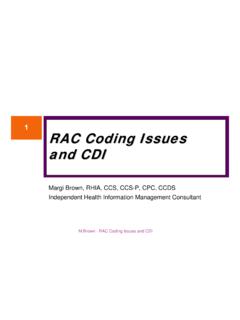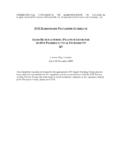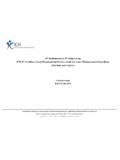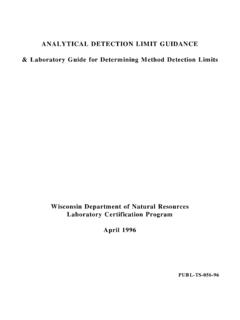Transcription of The Fitness for Purpose of Analytical Methods - Eurachem
1 The Fitness for Purpose of Analytical MethodsA Laboratory guide to Method validation and Related TopicsSecond Edition 2014 The Fitness for Purpose of Analytical MethodsA Laboratory guide to Method validation and Related TopicsSecond Edition 2014 i Eurachem guide The Fitness for Purpose of Analytical Methods A Laboratory guide to Method validation and Related Topics Second edition Acknowledgements This document has been produced by members of the Eurachem Method validation Working Group and others co opted for this task. Those who have contributed to this edition are listed below. Project group Vicki Barwick LGC (UK) Pedro P. Morillas Bravo Canal de Isabel II Gesti n (ES) Stephen L. R. Ellison LGC (UK) Joakim Engman National Food Agency (SE) Elin L. F. Gjengedal Norwegian University of Life Sciences (NO) Ulla Oxenb ll Lund Eurofins Milj A/S (DK) Bertil Magnusson (editor) SP Technical Research Institute of Sweden (SE) Hans Thomas M ller Mersin (TR) Marina Patriarca Istituto Superiore di Sanit (IT) Barbara Pohl Merck KGaA (DE) Piotr Robouch European Commission (EU) Lorens P.
2 Sibbesen (chairman) Labquality International (DK) Elvar Theodorsson University Hospital in Link ping (SE) Florent Vanstapel University Hospital Leuven, Leuven (BE) Isabelle Vercruysse BELAB (BE) Aysun Yilmaz Cevre Food and Industrial Analysis Laboratory (TR) Perihan Yolci meroglu Okan University (TR) Ulf rnemark (editor) Emendo Dokumentgranskning (SE) Copyright Copyright of this document is held by the contributing authors. All enquiries regarding reproduction in any medium, including translation, should be directed to the Eurachem secretariat. The text may not be copied for resale. Recommended citation This publication should be cited* as: B. Magnusson and U. rnemark (eds.) Eurachem guide : The Fitness for Purpose of Analytical Methods A Laboratory guide to Method validation and Related Topics, (2nd ed. 2014). ISBN 978 91 87461 59 0. Available from *Subject to journal requirements ii The Fitness for Purpose of Analytical Methods Eurachem guide iii Contents Foreword to the second edition.
3 1 Foreword to the first edition .. 2 Abbreviations and symbols .. 3 1 Introduction .. 5 Rationale and scope for this guide .. 5 Notes on the use of this guide .. 5 Terminology .. 5 Quick References .. 6 2 What is method validation ? .. 7 Definitions .. 7 What is the difference between validation and verification? .. 7 3 Why is method validation necessary? .. 9 Importance of Analytical measurement .. 9 The professional duty of the Analytical chemist .. 9 Method development .. 9 4 When should Methods be validated or verified? .. 11 Method 11 Method verification .. 11 5 How should Methods be validated? .. 13 Who carries out method validation ? .. 13 Approaches to method validation ..13 Interlaboratory approach ..13 Single laboratory approach ..13 Extent of validation studies .. 13 validation plan and report .. 14 validation tools .. 15 Routine test samples ..15 Spiked materials/solutions.
4 15 Incurred materials ..15 Measurement standards ..15 Statistics ..16 validation requirements .. 16 Method validation process .. 16 6 Method performance characteristics .. 19 Selectivity .. 19 Terms and definitions ..19 Effects of interferences ..19 Assessment of selectivity ..19 The Fitness for Purpose of Analytical Methods Eurachem guide iv Limit of detection and limit of quantification .. 20 Terms and definitions ..20 Determination of the standard deviation at low levels ..21 Estimating LOD ..24 Estimating LOQ ..24 Alternative procedures ..25 Capability of detection for qualitative analysis ..25 Working range .. 27 Definition ..27 Considerations for the validation study ..27 Method and instrument working Assessing instrument working range ..27 Assessing method working range ..28 Analytical sensitivity .. 30 Definition ..30 Applications ..30 Trueness .. 30 Terminology to describe measurement quality.
5 30 Determination of bias ..31 Interpreting bias measurements ..34 Precision .. 35 Replication ..35 Precision conditions ..35 Precision limits ..36 Simultaneous determination of repeatability and intermediate precision ..36 Measurement uncertainty .. 38 Ruggedness .. 38 Definition ..38 Ruggedness test ..38 7 Using validated Methods .. 41 8 Using validation data to design quality control .. 43 Introduction .. 43 Internal quality control .. 43 External quality control .. 44 9 Documentation of validated Methods .. 45 From draft to final version .. 45 Recommendations .. 45 Checking the instructions ..45 Recommendations in standards ..45 Document control ..45 10 Implications of validation data for calculating and reporting 47 Annex A Method documentation protocol .. 49 Annex B Statistical basis of limit of detection calculations .. 53 Annex C Analysis of variance (ANOVA) .. 54 Annex D Notes on qualitative analysis.
6 56 Bibliography .. 59 The Fitness for Purpose of Analytical Methods Eurachem guide MV 2014 1 Foreword to the second edition Since the first edition of this guide in 1998, a number of important developments in Analytical quality have taken place. Firstly, the ISO 9000 series of standards, which is widely used to provide a basis for a quality management system, has been revised. Its philosophy forms an integral part of international conformity assessment standards and guides, which underpins competence requirements for laboratories, proficiency testing (PT) providers and reference material (RM) producers. These documents all stress the importance of using validated Methods . Secondly, several general or sector specific guides on method validation have been revised or developed. EU legislation contains mandatory requirements for Analytical measurements in many sectors. Thirdly, much effort has been invested by the Analytical community in implementing the uncertainty concept.
7 For example, in its Harmonized guidelines for single laboratory validation of Methods of analysis (2002) IUPAC predicted that, ..with an increasing reliance on measurement uncertainty as a key indicator of both Fitness for Purpose and reliability of results, Analytical chemists will increasingly undertake measurement validation to support uncertainty . In the following years, accreditation bodies issued policies and guidance documents clearly recognising the use of method validation data in the measurement uncertainty estimation process. Furthermore, the International vocabulary of metrology Basic and general concepts and associated terms (VIM) has been substantially revised, taking into account chemical and biological measurements. Although terminology related to method validation is far from harmonised, the situation has improved. VIM is also a normative document for laboratories accredited to, ISO/IEC 17025 and ISO 15189.
8 The second edition of this guide aims to reflect changes in international standards and guidance documents and puts less emphasis on terms and definitions. Instead the guide refers to the VIM and other readily available sources. As a consequence, the list of terms and definitions has been omitted from the Annex. Literature cited in this edition of this guide are listed in the Bibliography at the end. Additional sources and literature related to method development and validation is available as a Reading list under the menu item Publications on the Eurachem website at Annex A is revised as a consequence of changes to ISO 78 2. This edition has also been extended to include information on the statistical basis of limit of detection calculations (Annex B), analysis of variance (Annex C) and qualitative analysis (Annex D). It is becoming increasingly common among routine laboratories, especially in the clinical sector, to use commercially available measuring systems.
9 This means that the responsibility for validation mainly lies with the manufacturer. The laboratory s work will focus on verifying the manufacturer s published performance data and demonstrate that the method works on the end user s premises. However, looking back to the foreword to the first edition, we conclude that the six principles stated there are still relevant, and are consistent with the requirements of international standards such as ISO/IEC 17025. The Fitness for Purpose of Analytical Methods Eurachem guide MV 2014 2 Foreword to the first edition* An initiative in the UK to promote good practice in Analytical measurement has identified six principles of Analytical practice which, taken together, are considered to constitute best practice. The six principles which are described in more detail in a separate guide are: 1. Analytical measurements should be made to satisfy an agreed requirement. ( to a defined objective).
10 2. Analytical measurements should be made using Methods and equipment which have been tested to ensure they are fit for Purpose . 3. Staff making Analytical measurements should be both qualified and competent to undertake the task. (and demonstrate that they can perform the analysis properly). 4. There should be a regular independent assessment of the technical performance of a laboratory. 5. Analytical measurements made in one location should be consistent with those made elsewhere. 6. Organisations making Analytical measurements should have well defined quality control and quality assurance procedures. These principles are equally relevant to laboratories whether they are working in isolation or producing results which need to be compared with those from other laboratories. This document is principally intended to assist laboratories in implementing Principle 2, by giving guidance on the evaluation of testing Methods to show that they are fit for Purpose .
